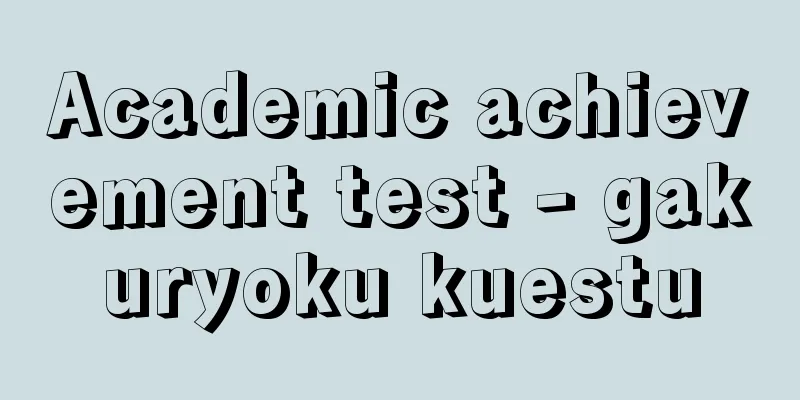Koyo Gunkan - Koyo Gunkan

|
A military chronicle created in the early Edo period. 20 volumes, 59 articles in total. Obata Kagenori, the founder of the Koshu school of military tactics, used this book as the basic source, and used the 3 volumes and 27 articles of "Suegaki" (Summary) and the 9 articles of "Ketsuyohon" (Conclusion) and the 3 articles of "Ryu-Ko-Hyo" (Ryu-Ko-Hyo) as materials for his military tactics lectures. It describes the military achievements and military strategies of the famous warlord Takeda Shingen, as well as governance, criminal law, and military law, and is particularly detailed in its descriptions of camps, soldiers, and tools. To this are added the biography of Katsuyori (50 articles and below), and the story of Tokugawa Ieyasu at the end (59 articles). There are errors in the dates and facts, so it cannot be said to be an actual record of the Takeda clan, but the thoughts and actions of the Koshu samurai are vividly and powerfully written, and the author's intention to make it a "source of etiquette for samurai of all ranks" is apparent everywhere. There have been many different theories about the creation of this book, including the theory that it is a forgery, since the Edo period, but since the mid-Meiji period it has been believed to have been written based on the words of Kousaka Danjo no Jō Masanobu (1527-78), commonly known as Kousaka Danjo, who was a favorite of Shingen and served as castle lord of Kaizu in Shinshu (Nagano Prefecture), and that his relatives Kasuga Sojirō and Okura Hikojurō edited and added to it, and that Obata Kagenori augmented and compiled it. However, in recent years, analysis of the book has progressed, and the theory that Masanobu should have been the original author has been put forward. [Ichiro Watanabe] "Koyo Gunkan (The Mirror of the Battle of Koyo)" by Isogai Hajime and Hattori Harunori (1965, Jinbutsu Oraisha) Source: Shogakukan Encyclopedia Nipponica About Encyclopedia Nipponica Information | Legend |
|
江戸初期につくられた軍記。全20巻、59品。甲州流兵法の祖小幡景憲(おばたかげのり)は、本書を基本的原典とし、これに『末書』3巻・27品、『結要本』9品、『竜虎豹』3品をもって兵法講義の素材とした。戦国の名将武田信玄(しんげん)一代の戦功・武略を中心に、治政、刑法、軍法などについて記したもので、とくに陣営、兵伍(へいご)、諸道具などの記述が詳しい。これに勝頼(かつより)の一代記(50品以下)、最後(59品)に徳川家康の物語が付加されている。年代や事実の錯誤がみられ、武田氏の実録とはいえないが、甲州武士の思考や行動が生々しい迫力で綴(つづ)られており、「上下諸侍(しょざむらい)の作法の資」としようとする作者の意図が随所にうかがえる。 本書の成立については、すでに江戸時代から偽書説や多くの異説があるが、明治中期以後は、信玄の寵臣(ちょうしん)で信州(長野県)海津(かいづ)の城代を勤めた高坂弾正忠昌信(こうさかだんじょうのじょうまさのぶ)(1527―78)、通称高坂弾正の言を籍(か)りて、彼の縁者春日惣二郎(かすがそうじろう)・大蔵彦十郎らが編集・加筆し、これを小幡景憲が増補・集成したものとみられてきた。しかし近年本書の分析が進み、昌信を原作者とすべきであるとする説が唱えられている。 [渡邉一郎] 『磯貝一・服部治則註『甲陽軍鑑』(1965・人物往来社)』 出典 小学館 日本大百科全書(ニッポニカ)日本大百科全書(ニッポニカ)について 情報 | 凡例 |
<<: Chronicles of the Koyo Army
Recommend
Hormuz
... In the late Buyid period, the island of Kish,...
Pomerell
...After about half a century of fierce fighting,...
Fregata ariel (English spelling) Fregataariel
…[Hiroshi Hasegawa]. … *Some of the terminology e...
Islamic tiles
…These Abbasid luster tiles are quite large, bein...
Warm nuclear structure
...Typhoons that appear in the western North Paci...
Square seal - Kakuin
...The size of a seal that can be registered is s...
Porcelain
…a general term for pottery, earthenware, stonewa...
beyond a reasonable doubt
…Furthermore, a defendant cannot be found guilty ...
Film director - eiga kanto (English spelling)
The director is the creative director who directs...
Gengou, O. (English spelling) GengouO
…Once infected, it is said that one is immune to ...
Careful - Shinto
Date of birth and death unknown. A legalist think...
Pieta (English spelling) Pietà Italian
In Christian art, this is a devotional image of t...
Sandan no mai - Sandan no mai
The name of a dance in Noh and Kyogen. In Noh, it ...
Skirt - skirt (English spelling)
It refers to the lower body clothing for women. I...
Kennedy extractor
...There are many ideas for the specific form. Th...









